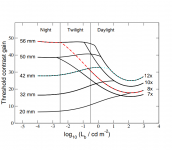Lee,
It seems that you have not understood the fundamental points debated in this thread so I'll recap on a few points.
Rico claimed in #1 to have invented a formula that shows that the luminous power of a binocular changes with magnification. Totally impossible by the laws of physics. In #4 and #6 I pointed out that brightness perception was totally different from luminous power and that magnification just made things more visible, and started to explain why in #8, pointing out that research by Leica (Leitz) and Zeiss by two measures had found that binocular perceived performance was proportional to magnification. This again showed his formula was nonsense. I even did the little test he requested in #10. Attempts to explain things further both in the thread and by PM were met with dismissal and insults.
I could go on pointing out details in this in other threads that show the flaws and contradictions in his
numerous posts, and his confusion is absolutely underlined in #33 that shows even he has lost track of what parameter his formula might refer too. The undeniable fact is, that it is none of them. It's total garbage.
As for the test he is requesting, that was published in 1943 by Berek as I mentioned at the start. I hope Holger doesn't mind me posting one plot from his paper on Berek's work that shows visibility is simply proportional to magnification in the luminance range he suggests.
David
It seems that you have not understood the fundamental points debated in this thread so I'll recap on a few points.
Rico claimed in #1 to have invented a formula that shows that the luminous power of a binocular changes with magnification. Totally impossible by the laws of physics. In #4 and #6 I pointed out that brightness perception was totally different from luminous power and that magnification just made things more visible, and started to explain why in #8, pointing out that research by Leica (Leitz) and Zeiss by two measures had found that binocular perceived performance was proportional to magnification. This again showed his formula was nonsense. I even did the little test he requested in #10. Attempts to explain things further both in the thread and by PM were met with dismissal and insults.
I could go on pointing out details in this in other threads that show the flaws and contradictions in his
numerous posts, and his confusion is absolutely underlined in #33 that shows even he has lost track of what parameter his formula might refer too. The undeniable fact is, that it is none of them. It's total garbage.
As for the test he is requesting, that was published in 1943 by Berek as I mentioned at the start. I hope Holger doesn't mind me posting one plot from his paper on Berek's work that shows visibility is simply proportional to magnification in the luminance range he suggests.
David
Attachments
Last edited by a moderator:





